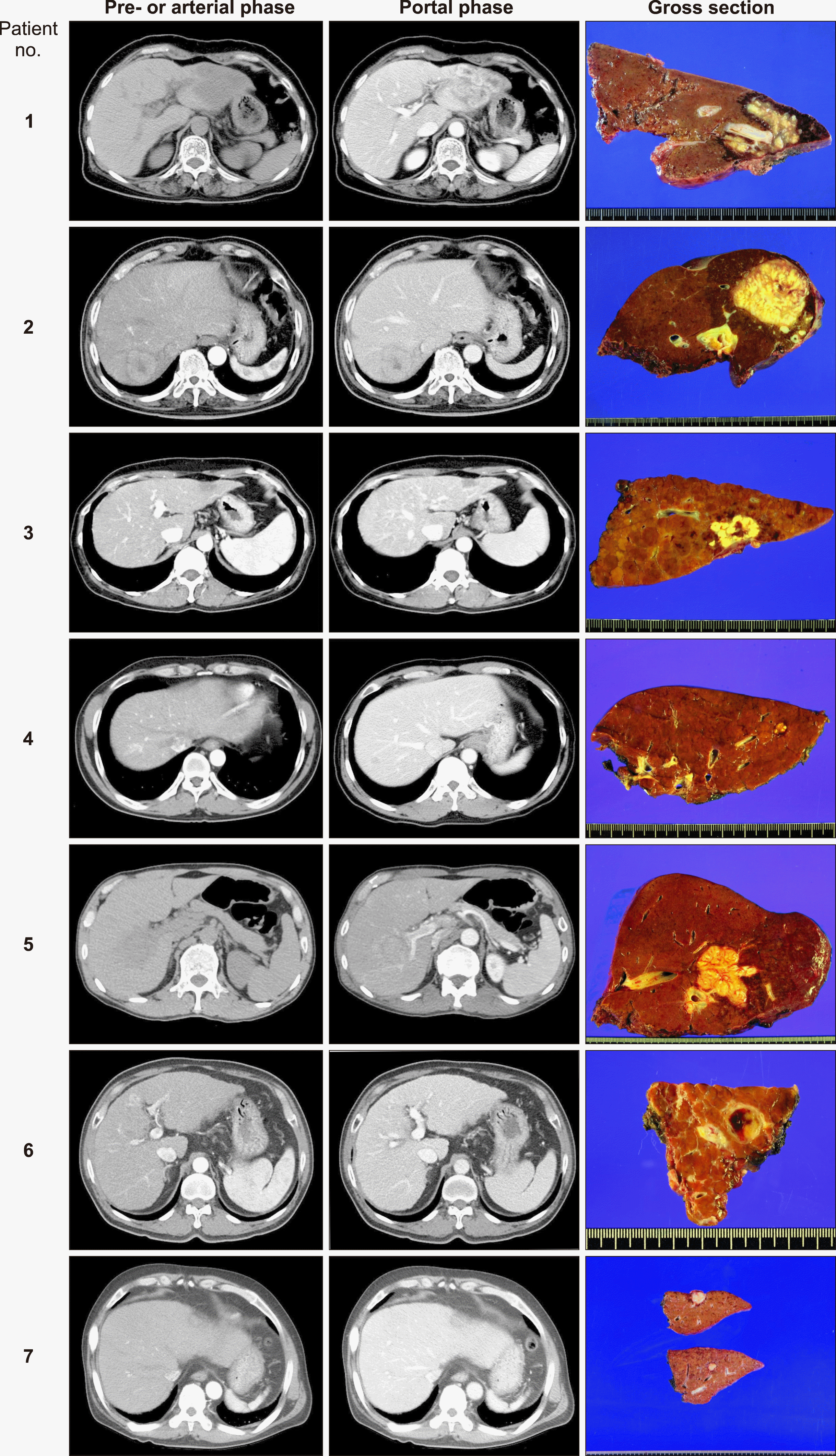1. Torzilli G, Inoue K, Midorikawa Y, Hui AM, Takayama T, Makuuchi M. 2001; Inflammatory pseudotumors of the liver: prevalence and clinical impact in surgical patients. Hepatogastroenterology. 48:1118–1123. PMID:
11490814.

3. Yamamoto H, Yamaguchi H, Aishima S, Oda Y, Kohashi K, Oshiro Y, et al. 2009; Inflammatory myofibroblastic tumor versus IgG4- related sclerosing disease and inflammatory pseudotumor: a comparative clinicopathologic study. Am J Surg Pathol. 33:1330–1340. DOI:
10.1097/PAS.0b013e3181a5a207. PMID:
19718789.

4. Zen Y, Fujii T, Sato Y, Masuda S, Nakanuma Y. 2007; Pathological classification of hepatic inflammatory pseudotumor with respect to IgG4-related disease. Mod Pathol. 20:884–894. DOI:
10.1038/modpathol.3800836. PMID:
17571078.


5. White JE, Chase CW, Kelley JE, Brock WB, Clark MO. 1997; Inflammatory pseudotumor of the liver associated with extrahepatic infection. South Med J. 90:23–29. DOI:
10.1097/00007611-199701000-00005. PMID:
9003818.


6. Kitajima K, Shiba H, Nojiri T, Uwagawa T, Ishida Y, Ichiba N, et al. 2007; Intrahepatic cholangiocarcinoma mimicking hepatic inflammatory pseudotumor. J Gastrointest Surg. 11:398–402. DOI:
10.1007/s11605-006-0071-1. PMID:
17458614.


7. Ishida H, Tatsuta M, Furukawa H, Ohta H, Hashimoto K, Hayashi N, et al. 2000; Multiple inflammatory pseudotumors mimicking liver metastasis from colon cancer: report of a case. Surg Today. 30:530–533. DOI:
10.1007/s005950070121. PMID:
10883465.


8. Fukuya T, Honda H, Matsumata T, Kawanami T, Shimoda Y, Muranaka T, et al. 1994; Diagnosis of inflammatory pseudotumor of the liver: value of CT. AJR Am J Roentgenol. 163:1087–1091. DOI:
10.2214/ajr.163.5.7976880. PMID:
7976880.


9. Park JY, Choi MS, Lim YS, Park JW, Kim SU, Min YW, et al. 2014; Clinical features, image findings, and prognosis of inflammatory pseudotumor of the liver: a multicenter experience of 45 cases. Gut Liver. 8:58–63. DOI:
10.5009/gnl.2014.8.1.58. PMID:
24516702. PMCID:
PMC3916688.


10. Nam KJ, Kang HK, Lim JH. 1996; Inflammatory pseudotumor of the liver: CT and sonographic findings. AJR Am J Roentgenol. 167:485–487. DOI:
10.2214/ajr.167.2.8686633. PMID:
8686633.


11. Yoon KH, Ha HK, Lee JS, Suh JH, Kim MH, Kim PN, et al. 1999; Inflammatory pseudotumor of the liver in patients with recurrent pyogenic cholangitis: CT-histopathologic correlation. Radiology. 211:373–379. DOI:
10.1148/radiology.211.2.r99ma36373. PMID:
10228516.


13. Vassiliadis T, Vougiouklis N, Patsiaoura K, Mpoumponaris A, Nikolaidis N, Giouleme O, et al. 2007; Inflammatory pseudotumor of the liver successfully treated with nonsteroidal anti-inflammatory drugs: a challenge diagnosis for one not so rare entity. Eur J Gastroenterol Hepatol. 19:1016–1020. DOI:
10.1097/MEG.0b013e32821acdd2. PMID:
18049174.


14. Koea JB, Broadhurst GW, Rodgers MS, McCall JL. 2003; Inflammatory pseudotumor of the liver: demographics, diagnosis, and the case for nonoperative management. J Am Coll Surg. 196:226–235. DOI:
10.1016/S1072-7515(02)01495-3. PMID:
12595051.


15. Yamaguchi J, Sakamoto Y, Sano T, Shimada K, Kosuge T. 2007; Spontaneous regression of inflammatory pseudotumor of the liver: report of three cases. Surg Today. 37:525–529. DOI:
10.1007/s00595-006-3433-0. PMID:
17522777.


16. Hwang S, Ha TY, Song GW, Jung DH, Ahn CS, Moon DB, et al. 2015; Quantified risk assessment for major hepatectomy via the indocyanine green clearance rate and liver volumetry combined with standard liver volume. J Gastrointest Surg. 19:1305–1314. DOI:
10.1007/s11605-015-2846-8. PMID:
25947549.


17. Park KS, Jang BK, Chung WJ, Cho KB, Hwang JS, Kang YN, et al. 2006; Inflammatory pseudotumor of liver--a clinical review of 15 cases. Korean J Hepatol. 12:429–438. PMID:
16998295.

18. Ahn KS, Kang KJ, Kim YH, Lim TJ, Jung HR, Kang YN, et al. 2012; Inflammatory pseudotumors mimicking intrahepatic cholangiocarcinoma of the liver; IgG4-positivity and its clinical significance. J Hepatobiliary Pancreat Sci. 19:405–412. DOI:
10.1007/s00534-011-0436-z. PMID:
21894477.


19. Sakai T, Shiraki K, Yamamoto N, Kawakita T, Ohmori S, Itoh I, et al. 2002; Diagnosis of inflammatory pseudotumor of the liver. Int J Mol Med. 10:281–285. DOI:
10.3892/ijmm.10.3.281. PMID:
12165801.


20. Toda K, Yasuda I, Nishigaki Y, Enya M, Yamada T, Nagura K, et al. 2000; Inflammatory pseudotumor of the liver with primary sclerosing cholangitis. J Gastroenterol. 35:304–309. DOI:
10.1007/s005350050351. PMID:
10777162.


23. Shek TW, Ng IO, Chan KW. 1993; Inflammatory pseudotumor of the liver. Report of four cases and review of the literature. Am J Surg Pathol. 17:231–238. DOI:
10.1097/00000478-199303000-00003. PMID:
8382011.





 PDF
PDF Citation
Citation Print
Print




 XML Download
XML Download